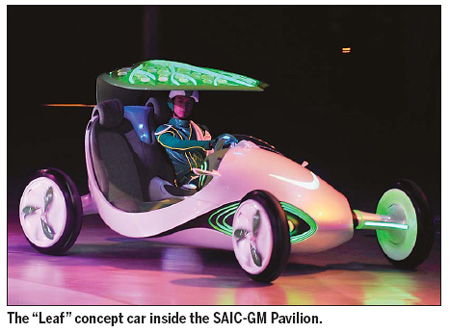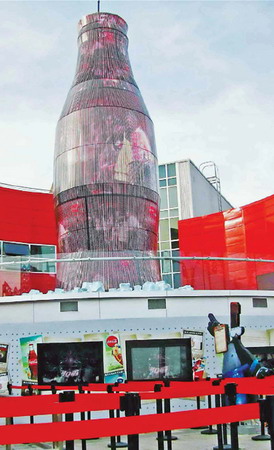The future is ours to see

While the national and regional pavilions on the Pudong side of the Expo 2010 Shanghai share history, cities, culture and daily life with visitors, corporate pavilions on the other side of the Huangpu River in Puxi offer a glimpse into the future of urban life.
From traffic-free streets to soda bottles made from plant fiber, the corporate pavilions are demonstrating how future advancements will make for better cities and better lives.
"If the stunning national pavilions in the Pudong area are about what we have today, pavilions in the Puxi section focus more on showing what we will have in the future," said Jin Qi, the SAIC-GM Pavilion managing director.
Themed "Take a Drive to 2030", the SAIC-GM Pavilion is designed to present an idealistic view of urban transportation in 2030. It shows driving in a futuristic city that is free of traffic congestion, carbon emission and accidents. The pavilion even constructed a road-like path that takes visitors to the pavilion's vision of the future.
 |
| A giant bottle of Coca-Cola outside the Coca-Cola pavilion in Puxi. |
A 10-minute film called 2030 Move, is played in the pavilion's theater with its 488 zero-delay motion seats. The film highlights solutions to five problems in urban areas.
Jin said the pavilion organizers consulted 27 experts worldwide to discover which five problems urgently need to be solved.
"Electrification, network connection and auto-driving are three key technologies in creating a new urban transportation system shown in the film," said Jin. "Some concepts have been realized, so 20 years is long enough for us to integrate all those technologies to achieve the target."
That's why the pavilion has chosen 2030 - its not too far away, he said. "Most visitors to the Expo Garden in 2010 will have a chance to witness and experience the change in the next two decades."
Just 10 minutes away from the SAIC-GM Pavilion, the world's leading network developer, Cisco, has also created a short movie - set in 2020 and focused on Shanghai - to show what life will be like in the future, when real-time information transmission technology is being widely used in big cities like Shanghai.
Themed "Smart + Connected Life", the Cisco Pavilion is spread out across more than 1,500 square meters and is designed to provide solutions to problems triggered by urbanization.
"Urbanization has imposed great pressure on city management," said Anthony Elvey, director of the Cisco Pavilion. "To handle those challenges, cities need to make technology the core of their development."
The United Nations estimates that the world's urban population will grow from 50.5 percent in 2010 to 69.6 percent in 2050 and the growth will occur almost entirely in developing countries.
"The core of our pavilion is to show what a city will look like in 2020, what kind technology will enable citizens to enjoy a better life," said Elvey.
The eight-minute movie plays in the main hall of the Cisco Pavilion and shows what life will be like in 2020, when all people can share data over a broadband network.
"By telling a story about a family with three generations in Shanghai in 2020, we want to show how services like transportation, education and health care could be better when they are interconnected by an intelligent network," said Elvey.
The Coca-Cola Pavilion, themed "A World Refreshed with Happiness", offers a different experience and shows visitors how their products are becoming more eco-friendly. The pavilion has brought more than 1 million special bottles of Coca-Cola to the Expo to give to visitors.
The bottles are partially made with plant fibers, reducing the company's reliance on petroleum, a non-renewable resource, to help in plastic bottle production.
"The bottles are produced with petroleum-based materials and up to 30 percent from plants," said Wasim Basir, market activation director of Coca-Cola.
The environmentally friendly bottles are made through an innovative process that turns sugar cane and molasses into a key component for PET plastic production.
"The oil reserves in the world will not go beyond another 30 or 40 years, so where can we get the plastic?" said Basir.
Basir said the company is the first beverage manufacturer in the world that bottles beverages with containers made with plant fiber. And good news for Coke drinkers, the bottles don't affect the taste.
"This is our first step toward a 100 percent plant-made bottle. Hopefully in the future we will not have plastic bottles," said Basir. "The innovation suggests where we are going in the future."
Coca-Cola understands its role in improving people's lives with their products. "For better lives, corporations need to take more responsibility in caring about the environment," said Basir.
As the most eye-catching pavilion in the Puxi section, the Japanese Industry Pavilion has brought something unique to the Expo. The pavilion has seen more than 300,000 visitors since May 1. However, visitors need to wait up to two hours to visit the pavilion.
With participation from 41 enterprises, the Japan Industry Pavilion shows visitors a wonderful urban life in Japan.
An eight-minute movie called UTAGE presents modern life in Japan and can be summarized into three words - kirei, kawaii and kimochiii, or clean, cute and comfortable.
"The video allows visitors to explore and capture the essence of urban life in Japan," said Zhang Shenbo, vice-director of the Japan Industry Pavilion.
The cutting-edge toilet technology presented by bathroom solution providers INAX has been popular for visitors with its claim of "the most comfortable toilet in the world".
This prized potty, which costs about 60,000 yuan ($8,800), is one of the pavilion's most popular exhibits. It comes with some useful features: it flushes automatically, is self-cleaning and kills bacteria automatically.
"We are wondering about what we will happen in next 10 years," said Li Ming, a visitor from Sichuan province. "But we are more interested in knowing what we have now."
With the 70 million people expected to visit the Expo over six months, the exhibits in corporate pavilions provide an opportunity for people think about life in the future. While scientists and researchers may have developed the ideas, the pavilions try to translate them so that visitors can understand them in a day-to-day context and learn from them.
"Cutting edge technologies are showcased in the simplest ways so that everyone can understand," said Li Jichun, a visitor from Anhui province.
"We hope everything here can become a reality," said another visitor, surnamed Wang.
 0
0 







Go to Forum >>0 Comments